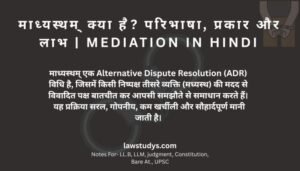Hello friends, In This article we have been told about the Schools of Criminology which is an important part of Criminology and competitive examination. An attempt has been made to explain in simple language what is the schools of criminology, how many types are there and how it developed, we hope that you will definitely like this article.
Introduction (Schools of Criminology)
The development of Criminology is considered to have started from the time of Cesar Bacaria (1735 to 1794), according to the country, time and circumstances, new crimes have been being born in the society and in the same sequence, for the last many years, criminals and crimes have been Many scholars (thinkers) have been propounding explanations or ideologies regarding their causes, their analysis and their prevention.
The ideologies of scholars have been different regarding crime, but the ideologies of some scholars have been similar. In this way, the schools of criminology has developed on the basis of explanations or ideologies created by thinkers from time to time in relation to crime, which are also called branches or sects of criminology.
For the convenience of study, scholars of similar ideologies have been divided into different groups, which are also called ideologies or branches of criminology and each ideology discusses in detail the causes of crime and criminal behavior according to its own point of view.
Read Also – What do you mean by doctrine of res judicata? | Essential Elements & Objective
Schools of Criminology
The Schools of Criminology includes such subjects in which different types of crimes and the rules and methods in their perspective are studied. The Schools of Criminology study the management of various types of crimes, judicial procedures from their perspective, the process of punishment and punishment, rights and duties of the criminal and the victim, and the moral and social aspects between crime and society.
For example – Jurisprudence branch of criminology studies the process of legal procedures, trial and official realization of a crime. If crime and its effects change in society with time, new branches may also arise from scientific, social and legal viewpoints.
According to Sutherland – the schools of criminology means ‘a group of supporters of the same ideology regarding the causes of crime and their ideas’. In simple language, it can be said that various sects or ideologies regarding crime and criminality mean a group of unanimous ideas that have similar views regarding the causes and prevention of crime.
Read Also – What is Public Interest Litigation? and its importance in India
Types of Schools of Criminology
As we know that according to the country, time and circumstances, many Schools of Criminology have been emerging from time to time. For the convenience of study, there are the following major ideologies or branches of criminology, which will be described in detail separately –
(i) Pre-Classical School
This is the oldest schools of criminology, which dates back to the 17th and 18th centuries, and Aquinas is considered to be its father. In pre-classical ideology, the main cause of crime was considered to be ghosts and invisible supernatural powers.
According to this School, the human soul is pure and virtuous and man is not a criminal by nature, rather man becomes under the control of unknown forces i.e. ghosts, devils, demons etc., then these evil spirits make man commit crimes. Thomas Aquinas, Hobbes, Locke, August Copte etc. are considered supporters of this ideology/School.
To get rid of evil spirits like ghosts, devils, demons etc., havan, mantra, sacrifice, fire test etc. were prevalent and at this time there was no permanent principle of punishment for crimes. Due to the dominance of religion in the society, there was no difference between crime and sin.
Read Also – Who is a Hindu According to Hindu law & to which persons does this method apply?
(ii) Classical School
The classical School originated in England in the latter half of the 18th century, the father of which is considered to be Cesare Beccaria. Among the supporters of this ideology, the names of thinkers like Blackstone, Bentham, Romile, Robert Peel, Feuer Bech etc. are prominent.
The main concept or focal point of this School is the free will of man, that is, whatever man does, he does it with his free will. In every work, he thinks about his benefit-disadvantage, good-bad, happiness-sorrow, etc., that is, the amount of happiness he gets from any work will be more than the pain he gets from the same work.
Man does it with the same willingness, Crime is also a result of this, that is, if a person gets pleasure from any work then he does that work even if that work is criminal. Jeremy Bentham’s utilitarian theory is also in line with this.
(iii) New-Classical School
The main reason for the origin of this School is considered to be the shortcomings of the classical school. As we know that in the classical ideology, along with the system of equal punishment for the same crime, it has also been explained that man does only that work in which he gets maximum happiness, even if it is a crime.
This was not acceptable to many criminologists and as a result the neo-classical ideology was born.
According to the neo-classical school, the main reason for crimes is not only the desire of a person to attain happiness but sometimes he also commits crimes due to compulsion or circumstances.
Therefore, the system of equal punishment for similar crimes is not fair. According to Donald and Taft, the amount of punishment should be determined keeping in mind the reasons, circumstances of the crime, age of the criminal, character, mental condition etc.
Thus, the neo-classical school was initiated mainly to remove the shortcomings of the classical school. The main names of supporters of this ideology are Rossi, Gerald, Jolly etc.
(iv) Typological School
This school emerged due to the shortcomings of the neo-classical ideology. According to this School, the reason for crimes is not only hedonistic philosophy but also the physical structure and mental condition of the criminal.
According to them, the physical structure and mental condition of a criminal person is somewhat different as compared to a normal human being and hence they can be identified.
The physical or mental characteristics of a criminal person are born or hereditary and these characteristics motivate him to commit crime. Supporters of this sect consider various types of physical symptoms as the main cause of crime, due to which many of its branches have developed, there are mainly three branches of this school –
– Lombroso or Italian branch
– Mental Testing Branch
– psychoanalytic branch
Criminologists like Lombroso, Enrico Ferri, Raphael Garofalo etc. have been considered strong supporters of this school. This school is sometimes also called positive school.
(v) Sociological School
It is also known as Socialist School. French legal expert Gabriel de Tarde is considered the father of this school, according to this ideology, the various social circumstances of a person are the cause of crime,
Supporters of this school consider lack of money, poverty and economic inequality as the main causes of crimes. When the gap between a rich person and a poor person increases and unemployment and underemployment take on a monstrous form, then class conflict arises and the person moves towards committing crimes.
Marx, Engels, Bongar etc. are considered to be strong supporters of socialist school, according to them the main reason for class struggle is capitalist economy.
According to Sutherland – crimes are not inborn but are learned by living in bad company, that is, a person learns criminal behavior in the same way as he learns other things in childhood.
(vi) Environmental School (Geographical and Ecological School)
This schools of criminology is also known as geographical or environmental ideology. This school was in progress from the year 1830 to the year 1880 and criminologists like Queteletche, Montesquieu, AM Guerrey, Kheri, Adolf, Lacson etc. have been the main supporters of this school.
The basis of this schools of criminology is geographical conditions because it searches for crimes in the external environment and not in the body, mind etc. of the criminal. According to this – climate, natural resources, geographical conditions etc. are responsible for the crime.
This school believes that favorable geographical and social environments reduce crime, whereas unfavorable environments encourage crime. Similarly, crimes are less in areas with abundance of natural resources and resources, whereas crimes are more in areas with scarcity.
Lacson has analyzed the crimes committed in different months and according to him, crimes against persons are more in the months of May and June and crimes against property are more in the month of December.
(vii) Multi-Factor School
This school is the most prevalent school at present, which is also known as multi-factor school. This school gives a very liberal interpretation of crime. Supporters of this ideology believe that there are not just one but many reasons for crimes and no single theory can be propounded without including all these reasons and without any counter argument.
They believe that crime is created by a combination of many circumstances and factors – anthropological, physical and social.
Dr. Burt has divided such factors into four parts –
(a) Major or most important factor,
(b) Main and supporting factors,
(c) Non-primary or secondary circumstances leading to the crime
(d) Conditions which, despite being present, are not active
This school is supported by William Healy’s theory of multifactorialism, while Albert Cohen has bitterly criticized this school, according to him, multifactorialist scholars criticize a factorialist theory because of not understanding it properly, but their criticism does not have much force. have been found.
(viii) Socialist ideology
The origin of this school is considered to be from around 1850 AD. Karl Marx, Engels, Bonger are considered to be the exponents of socialist school, according to whom crime is directly related to economic conditions.
If economic conditions are favorable for humans then the rate of crime will decrease and if it is opposite then the rate of crime will increase. it will be done
Sutherland calls it a scientific principle because this principle works from a general hypothesis and collects data in such a way that on its basis other people can also repeat the work and check their findings.
Related Post –
What are the Essential Elements of Crime? | Criminal Law
What is Criminology : Introduction, Definition, Importance
Description of the Scope and Nature of Criminology
What is Fair Trial : Definition & its essential elements | CPC 1908
Note – If there is a need for amendment in the post, do share it.
Reference :- Criminology And Penology (Dr. Y.S. Sharma)




